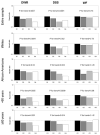Risk of dementia hospitalisation associated with cardiovascular risk factors in midlife and older age: the Atherosclerosis Risk in Communities (ARIC) study
- PMID: 19692426
- PMCID: PMC2783764
- DOI: 10.1136/jnnp.2009.176818
Risk of dementia hospitalisation associated with cardiovascular risk factors in midlife and older age: the Atherosclerosis Risk in Communities (ARIC) study
Abstract
Background: Cardiovascular risk factors are associated with a higher risk of developing dementia. Studies in older populations, however, have often failed to show this relationship. We assessed the association between cardiovascular risk factors measured in midlife and risk of being hospitalised with dementia and determined whether this association was modified by age and ethnicity.
Methods: We studied 11 151 participants in the population-based Atherosclerosis Risk in Communities cohort, aged 46-70 (23% African-Americans) in 1990-2, when participants underwent a physical exam and cognitive testing. Hospitalisations with dementia were ascertained through December 2004.
Results: During follow-up, 203 cases of hospitalisation with dementia were identified. Smoking (hazard ratio (HR), 95% CI 1.7, 1.2 to 2.5), hypertension (HR, 95% CI 1.6, 1.2 to 2.2) and diabetes (HR, 95% CI 2.2, 1.6 to 3.0) were strongly associated with dementia, in Caucasians and African-Americans. These associations were stronger when risk factors were measured at a younger age than at an older age. In analyses including updated information on risk factors during follow-up, the HR of dementia in hypertensive versus non-hypertensive participants was 1.8 at age <55 years compared with 1.0 at age 70+ years. Parallel results were observed for diabetes (HR 3.4 in <55, 2.0 in >or=70), smoking (4.8 in <55, 0.5 in >or=70) and hypercholesterolaemia (HR 1.7 in <55, 0.9 in >or=70)
Conclusion: In this prospective study, smoking, hypertension and diabetes were strongly associated with subsequent risk of hospitalisation with dementia, particularly in middle-aged individuals. Our results emphasise the importance of early lifestyle modification and risk factor treatment to prevent dementia.
Conflict of interest statement
None of the authors have any potential conflict of interest. Alvaro Alonso had full access to all the data in the study and takes responsibility for the integrity of the data and the accuracy of the data analysis.
Figures




Comment in
-
Vascular risk factors and dementia revisited.J Neurol Neurosurg Psychiatry. 2009 Nov;80(11):1183-4. doi: 10.1136/jnnp.2009.181289. J Neurol Neurosurg Psychiatry. 2009. PMID: 19864653 Free PMC article. No abstract available.
References
-
- Fitzpatrick AL, Kuller LH, Ives DG, et al. Incidence and prevalence of dementia in the Cardiovascular Health Study. J Am Geriatr Soc. 2004;52:195–204. - PubMed
-
- Hebert LE, Scherr PA, Bienias JL, et al. Alzheimer disease in the US population: prevalence estimates using the 2000 census. Arch Neurol. 2003;60:1119–22. - PubMed
-
- Borenstein Graves A. Alzheimer's disease and vascular dementia. In: Nelson LM, Tanner CM, Van Den Eeden SK, McGuire V, editors. Neuroepidemiology: from principles to practice. New York: Oxford University Press; 2004. pp. 102–30.
-
- Neuropathology Group of the Medical Research Council Cognitive Function and Ageing Study (MRC CFAS) Pathological correlates of late-onset dementia in a multicentre, community-based population in England and Wales. Lancet. 2001;357:169–75. - PubMed
Publication types
MeSH terms
Grants and funding
- N01 HC055022/HC/NHLBI NIH HHS/United States
- N01 HC055016/HL/NHLBI NIH HHS/United States
- N01 HC055019/HL/NHLBI NIH HHS/United States
- N01-HC-55016/HC/NHLBI NIH HHS/United States
- N01 HC055018/HC/NHLBI NIH HHS/United States
- N01 HC055015/HL/NHLBI NIH HHS/United States
- N01-HC-55021/HC/NHLBI NIH HHS/United States
- N01-HC-55019/HC/NHLBI NIH HHS/United States
- N01-HC-55015/HC/NHLBI NIH HHS/United States
- N01-HC-55020/HC/NHLBI NIH HHS/United States
- N01 HC055015/HC/NHLBI NIH HHS/United States
- N01-HC-55018/HC/NHLBI NIH HHS/United States
- N01 HC055016/HC/NHLBI NIH HHS/United States
- N01-HC-55022/HC/NHLBI NIH HHS/United States
- N01 HC055021/HL/NHLBI NIH HHS/United States
- N01 HC055020/HL/NHLBI NIH HHS/United States
- N01 HC055019/HC/NHLBI NIH HHS/United States
- N01 HC055021/HC/NHLBI NIH HHS/United States
- N01 HC055018/HL/NHLBI NIH HHS/United States
- N01 HC055022/HL/NHLBI NIH HHS/United States
- N01 HC055020/HC/NHLBI NIH HHS/United States
LinkOut - more resources
Full Text Sources
Medical
